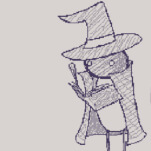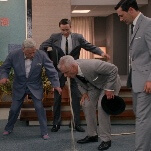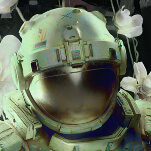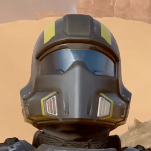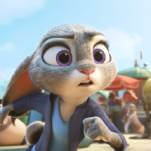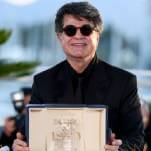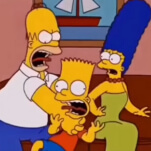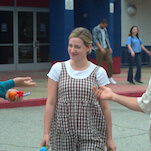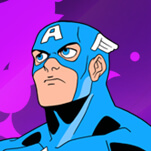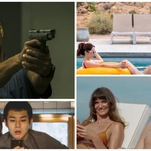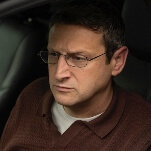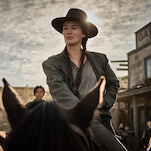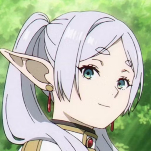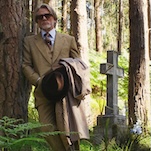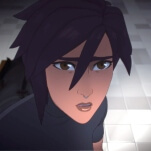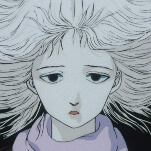What [Viselman] was doing was following the lead of Blake Carrington. To explain his go-for-broke strategy, Viselman—who is unabashed about his penchant for drawing life’s lessons from the plots of TV shows—recalls a scene from Dynasty, the ’80s prime-time soap. “Blake has just lost everything and Krystle was like, ‘Oh no, what are we going to do? What are we going to do?’ And Blake says something like … ‘Krystle, you open up that safe and you get out your best jewels. We’re throwing a party tonight!’”
Viselman’s recklessness paid off when he sold PBS on a British children’s show called Teletubbies, about strange, soft, toddler-like creatures with televisions in their abdomens who babble, dance around, and generally behave in ways soothing and compelling to extremely small children and nonsensical to adults. Teletubbies became a massive smash, but the show’s incredible success was soured by a falling-out that led Viselman to leave itsy bitsy.
Considering Viselman’s penchant for being inspired by pop-culture detritus, it’s appropriate that Oogieloves’ inspiration comes from an unlikely source. According to a Hollywood Reporter article, Oogieloves began its strange journey to infamy when Viselman attended a theatrical screening of Madea Goes To Jail. Viselman had long been trying to convince Anne Wood, the creator of Teletubbies, to let him bring her creation to the big screen by arguing that the entire paradigm of children’s films needed to be reinvented. Viselman was convinced that the problem with most kid films is that they demand that children behave like adults once they enter the theater, that the oppressive conventional paradigm forces children to repress their natural ebullience and propensity to scream obnoxiously for no discernible reason like, well, stupid fucking children, just so that adults around them do not instantly get migraine headaches and ponder slaughtering their young.
Then Viselman saw Madea Goes To Jail and the pieces began to come together. According to the article, Viselman found himself “marveling at the way the audience shouted advice to the characters and generally made the screening a community event instead of a solitary two hours.” The marketing visionary had stumbled upon a potentially life-changing idea: What if someone made a film that encouraged children to do all the things they weren’t supposed to do in a theater? What if he made a movie where kids were asked to get out of their seats and sing and dance and wobble and wiggle and act like children? What if someone made an interactive children’s film where the audience was as much a part of the show as the characters onscreen?
That was the beautiful, idiotic dream of The Oogieloves In The Big Balloon Adventure. Why should Tyler Perry fans be the only folks fortunate enough to experience a film that was a “community event” involving strangers yelling advice to fictional characters instead of a solitary two hours of tediously concentrating and thinking and losing yourself in a film’s narrative? Viselman was going to empower children to yell and scream and make noise and get out of their chairs and act a fool.
Viselman took a massive gamble. If he succeeded, he’d change the way children’s films are made, marketed, and processed. He’d be hailed as a genius, a revolutionary, possibly even some sort of marketing visionary. If he failed he’d be the subject of articles like this, alternately grim and gleeful post-mortems about a revolution in children’s entertainment that was simply not to be.
Viselman envisioned theaters shaking with laughter and song and dance as adoring, packed audiences cheered the Oogieloves along on their big balloon adventure. Instead, the film played to nearly empty theaters, even in its all-important first week. A week and a half after The Oogieloves In The Big Balloon Adventure opened on more than 2,000 screens nationwide, the only place to see it in Chicago was on a single screen in a theater deep in the South Side.
So on a Sunday afternoon I took my wife to see The Oogieloves In The Big Balloon Adventure at the I.C.E. Chatham 14 (I.C.E. stands for Inner City Entertainment) on 87th Street, where we were, not surprisingly, the only people in attendance. The woman running the box office made a half-hearted attempt to dissuade us from going into the film, pointing out alternatives we might find a little more to our liking, like The Avengers and Brave, films that might appeal to someone other than Oogieloves’ target demographic of children, the stoned, and the morbidly curious.
An experience that was meant to be joyous, communal, and designed around the short attention spans of small children had morphed into a de facto private screening. At least there were two souls in attendance; I imagine most screenings of Oogieloves played to empty theaters, where its constant pleas to an audience that did not exist must have played like something close to madness.
Actually, “something close to madness” is not a bad description for The Oogieloves In The Big Balloon Adventure. When a children’s film works, its universe, however fantastical or preposterous, has a sort of internal dream logic. No matter how strange it might be, it fundamentally makes sense. When a children’s film doesn’t work, however, its world begins to look freakish and grotesque. That’s the case with The Oogieloves In The Big Balloon Adventure, where a bizarre coterie of B- and C-list stars look less like colorful characters out of a children’s book than demented, demonic jesters out of a pneumonia-ravaged toddler’s agitated fever dream. Viselman has cited The Rocky Horror Picture Show as another inspiration for his interactive film, but when it comes to traumatizing innocent children, Tim Curry in drag has nothing on Oogieloves’ gallery of clattering grotesques.
The Oogieloves In The Big Balloon Adventure opens with the titular puppet-y oddballs shattering the fourth wall, Pirandello-style, and addressing the theatrical audience to crow that the film they are about to see is the “greatest movie ever.” At the risk of being harsh, the film does not live up to that billing. The Oogieloves then give the audience instructions. (Boo! Boo! Instructions!) But these aren’t the soul-crushing, joy-killing kind of instructions that tell you what not to do; they’re the sort of instructions that empower children! We are told that whenever we see butterflies gliding across the bottom of the movie screen we are to get up out of our seats, dance, and sing along to whatever annoying, clamorous ditty is being shrieked by the characters onscreen.
Here’s one of the many perplexing elements of The Oogieloves In The Big Balloon Adventure: Sometimes the words to its songs appear at the bottom of the screen, but most of the time they don’t, so audience members are often asked to sing along to songs that 1) they’ve never heard before, 2) they consequently don’t know the words to, and 3) are fucking terrible. Those three qualities make The Oogieloves In The Big Balloon Adventure the sing-along family movie that’s impossible to sing along to.
We’re then introduced to the Oogieloves. There’s Goobie, the Michael Nesmith of the group, right down to his winter hat. As evidenced by the fact that he wears glasses, he’s the intellect of the group, a turtle-green inventor prone to saying things like, “Bobby Wobbly, why do you wobble so much? Is your center of gravity misaligned?” Goobie plays guitar in the Oogieloves band, while Toofie is a purple-skinned, yellow-haired gentleman who plays drums, and is posited as the rollicking free spirit of the group (who, I would imagine, scores most of the groupies). Inspired possibly by prison and/or gang culture, Toofie refuses to wear a belt. Consequently, his pants fall down a lot. Whenever this happens, we are admonished to yell deliriously at the screen, “Goofy Toofie! Pull up your pants!” (Something similar occurred at the Royal Shakespeare Theater when John Gielgud’s pants were rigged during productions of The Tempest so that theater audiences—craving, like children and Tyler Perry fans, a truly interactive experience—were admonished to yell at the stage, “Goofy Gielgy, pull up your pants!”) Lastly, there is Zoozie. She is a girl.
The Oogieloves come equipped with instant catchphrases to match their single identifying characteristic. Zoozie’s catchphrase is “Sparkleliciousness,” Toofie’s is “Adventuriffic,” while Goobie’s is “Sciencetastic!” The Oogieloves’ songs and cheers, meanwhile, largely consist of the Oogieloves yelling the word “Oogielove” over and over again until the word “Oogielove” has lost all meaning. The Oogieloves In The Big Balloon Adventure feels less like a noble attempt to empower children and reinvent the kiddie film than a sadistic, out-of-control experiment in extreme branding, something out A Clockwork Orange but much more disturbing.
Oogieloves favors a Dresden-style approach, carpet-bombing audiences with constant reminders of the names of the toys they’re supposed to beg Mommy and Daddy to buy them just as soon as the movie lets out. Then again, considering the way Oogieloves totally reinvents the dominant kid-film paradigm, it’s entirely possible the filmmarketers (a word I’ve coined solely to describe Viselman and his ilk) want kids to start hollering for Toofie and Zoozie and Goobie dolls while the film is still running. (Incidentally, Viselman seems not to have succeeded in manufacturing a planned line of Oogieloves action figures.)
[pagebreak]
On the surface, Toofie, Zoozie, and Goobie look a lot like Teletubbies. Both have bottom-heavy, pear-shaped bodies, but Teletubbies are cute where Oogieloves are creepy. Oogieloves resemble Teletubbies the same way Mac, the McDonalds-and-M&M-obsessed star of Mac & Me, resembles E.T. Oogieloves are supposed to look plush and friendly, but their big, dead eyes and mouths are as distractingly inexpressive as their movements are lumbering and awkward. There’s a thin line separating creepy-cute from just plain repulsive, which Oogieloves crosses early and often.
In The Oogieloves In The Big Balloon Adventures, Oogieloves’ caretaker J. Edgar, a fussy living vacuum cleaner, loses five magical balloons he intended to give as a present to Schluufy, a sentient pillow that is either some sort of anthropomorphic baby or high off his ass. Schluufy leads an entirely sedentary existence, naps about 23 hours out a day, seems perpetually confused, and mumbles incoherently in a homemade vernacular only the Oogieloves understand. Yet his friends inexplicably feel the need to throw him (Her? It?) a surprise party all the same.
J. Edgar should be able to replace the missing balloons by visiting a shop that sells them, only they’re apparently the last five magic balloons left in all of Lovelyloveville, the grim hellscape where the film’s action takes place. So Toofie, Zoozie, and Goobie set off on their bikes to retrieve the five balloons while J. Edgar makes time with Windy Window, a sentient window with a woman’s face that J. Edgar clearly wants to stick his hose inside (if you catch my crude double entendre).
The plot finds the Oogieloves traveling to five different colorful locations, each with an accompanying paycheck-hungry actor, to retrieve a magical balloon. It’s as if Viselman came up with a rough treatment for an Oogieloves videogame, then figured he might as well save some time and money and have it double as the plot for a film. The Oogieloves In The Big Balloon Adventure feels a lot like the kind of elementary videogame small children beat on the first try, then throw away in disgust. The characters are outsized and over-the-top, the settings clearly distinguished, and the objectives clear. The five balloons also provide a convenient gauge of how much longer the film will linger before finally granting audiences their sweet freedom. (“Ugh, how many of those fucking balloons are left?” my wife asked me about three balloons in.)
First up, the Oogieloves visit a tree house where a raver girl lives with her polka-dot obsessed grandmother, played by Cloris Leachman. Leachman is apparently supposed to be a soothingly maternal, Mother Goose-like figure, but with her garish ragdoll makeup and polka-dot-heavy ensemble she looks and acts more like a cross between a human-sized candy cane and Bette Davis in Whatever Happened To Baby Jane? by way of Faye Dunaway’s Joan Crawford in Mommie Dearest.
After collecting a magic balloon from Leachman and her raver progeny, the Oogieloves travel to a milk diner where an anthropomorphic cow makes milkshakes fresh from her milky, nutrient-heavy teats at the behest of a 1950s-style hep-cat proprietor played by a raspy Chazz Palminteri, the young people’s favorite. At the diner, the Oogieloves score a second balloon when their talking fish—who is just like the fish in Pee-wee’s Playhouse only, you know, terrible—wins a milkshake-swilling contest with the balloon as the main prize. The Oogieloves then retrieve a third balloon from a sultry R&B diva (Toni Braxton) who favors them with a sexy ballad about the appropriate way to cough while wearing a scandalously low-cut gown that makes her heaving breasts the unmistakable focus of the scene, which is not what I imagine the makers of this G-rated family film intended.
For the fourth balloon, the Oogieloves visit a gentleman named Bobby Wobbly (Cary Elwes), whose surname doubles as a description of the way he walks. Bobby Wobbly was clearly intended as a reassuring cowboy sort familiar to even the smallest children. Instead, the pancake makeup on Elwes’ chalk-white visage and the grotesquely bowlegged manner in which he walks makes him seem like something from a deleted scene from Blue Velvet. Think of him as the half-mad, bubble-obsessed nephew of Dean Stockwell’s character.
The Oogieloves’ travels then take them to a giant sombrero powered by the magic of dance, particularly the mariachi moves of noted Hispanic icons Jaime Presley and Christopher Lloyd, the latter of whom communicates almost exclusively through the universal language of rhythm. It is during the sequence involving Lero and Lola Sombrero (as Lloyd and Pressley’s characters are known) that the film begins to approach the trippy, drugged-up weirdness of Sid and Marty Krofft productions, particularly, the famously stoner-friendly Lidsville. The Oogieloves In The Big Balloon Adventure speeds up the film, Benny Hill-style, while Lloyd displays his mastery of flamenco dancing, which is one way to make a 73-year-old look like he’s moving quickly and exuberantly.
The Oogieloves collect the five magical balloons, but then the balloons fly away and we are coldly informed that we the over-taxed audience, exhausted from being forced to constantly rise from our seats and boogie to crimes against music, must then blow kisses to the magical balloons to get them down. In the theater where I saw the film, not a single kiss was blown toward the screen, yet the magical balloons came down anyway, ensuring that a pillow so baked out of his gourd that he probably barely even knows whether he’s dead or alive can have a wonderful surprise party.
Oogieloves has the requisite happy ending, but fate had a much darker end in store for the filmmarketers behind this would-be revolution. In what is either delusional optimism or a complete break from reality, an unbowed Viselman claims that the film’s record-breaking opening weekend actually works in its favor. Talking to The Wrap, Viselman opined, “We’ve now got the notoriety we were trying to get for weeks before the film opened,” before vowing, “The attention we’re getting as a result of this is going to help our video-on-demand and DVD campaigns, and it’s going to help the next films, whether they’re theatrical releases or video.” In Viselman’s beautifully warped, Norma Desmond psyche, he’s still big, it’s the box-office grosses that got small. I imagine that at this moment Viselman is watching a Falcon Crest or Silk Stalkings rerun that will inspire his next revolutionary marketing conceit, whether it involves further adventures with the Oogieloves or not.
Failure, Fiasco Or Secret Success: Fiasco

